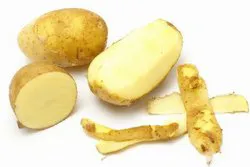 Fresh-cut potatoes (peeled, sliced or diced, and packed) are considered to have commercial interest in fresh-cut market as an alternative to pre-cooked or frozen potatoes.
Fresh-cut potatoes (peeled, sliced or diced, and packed) are considered to have commercial interest in fresh-cut market as an alternative to pre-cooked or frozen potatoes.One of the main causes of quality decay in fresh-cut potatoes is the enzymatic browning of the cut surfaces; this oxidation reaction can compromise seriously the shelf-life of the product. The rate of enzymatic browning in fruit and vegetables depends on the concentration of active PPO (polyphenol oxidase) and phenolic compounds, and on the presence of antioxidant compounds, such as ascorbic acid, that may control the PPO activity. In fresh-cut potatoes, the enzymatic browning is positively correlated to the PPO activity and phenol content.
Scientists at University of Foggia (Italy) published on ‘American Journal of Potato Research’ a study on the suitability of 4 early potato cultivars (Solanum tuberosum L.) to be processed as fresh-cut product.
For the study, ‘Ariana’, ‘Liseta’, ‘Safrane’, ‘Spunta’ cultivars were tested. Potatoes were processed as fresh-cut product (peeled, washed, cut into cubes, and packed), then the fresh-cut potatoes were stored at 5°C for 8 days and at 20°C for 6 days.
The suitability to the fresh-cut processing and the shelf-life quality were evaluated by measuring the enzymatic browning rate of cut surfaces, color change, PPO activity, ascorbic acid, dehydroascorbic acid, vitamin C, sugars, total phenol content (expressed as mg of gallic acid equivalents per 100 g of fresh weight), antioxidant activity (expressed as mg of Trolox equivalents per 100 g of fresh weight), and overall appearance evaluation.
Click here to enlarge.
Results showed that the initial chemical composition may influence both the enzymatic browning incidence and the fresh-cut potato quality during shelf-life.
‘Safrane’ resulted the cultivar with the best appearance during the first days of storage with lesser color changes. ‘Ariana’ and ‘Liseta’ also showed good performance, whereas ‘Spunta’ resulted to be the least suitable to be processed as fresh-cut product.
These results can be explained by the differences among the cultivars particularly in antioxidant activity and enzyme activity.
‘Safrane’ showed a high ascorbic acid content and antioxidant activity which could reduced the oxidative reactions, despite its high initial phenol content. Furthermore, PPO activity for this cultivar was relatively low. ‘Ariana’ showed the highest PPO activity and a relatively high phenol content, but it did not show a more severe browning than the other cultivars. This could be due to the high vitamin C content that has protected the cut surfaces against oxidation. ‘Liseta’ showed high ascorbic acid content, lower phenol content and PPO activity, this combination of factors let the cultivar to have a good performance. ‘Spunta’ showed the lowest ascorbic acid content and a higher phenol content, resulting in a lower resistance to browning.
The present study is in addition to a previous published work on late potato cultivars screening, these studies may help to supply the fresh-cut industry with raw materials suitable for processing throughout the year, according to the potato seasonal availability.
Original research. Cornacchia R., Cabezas-Serrano A.B., Amodio M.L., Colelli G., "Suitability of 4 potato cultivars (Solanum tuberosum L.) to be processed as fresh-cut product. Early Cultivars", 2011, American Journal of Potato Research, Volume No. 88(5), pagg. 403-412. Further info: link.springer.com/article/10.1007%2Fs12230-011-9206-3?LI=true
